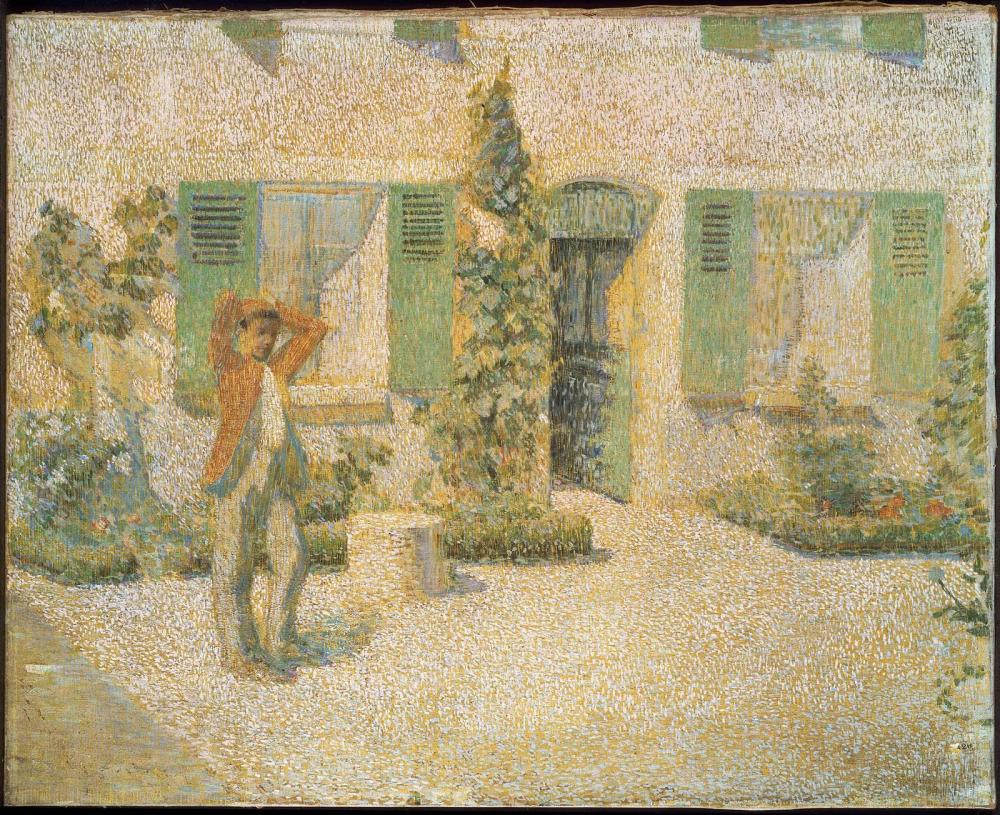Advanced Search 

French Farmhouse
Philip Leslie Hale (American, 1865–1931)
about 1893
Medium/Technique
Oil on canvas
Dimensions
64.77 x 81.28 cm (25 1/2 x 32 in.)
Credit Line
Gift of Nancy Hale Bowers
Accession Number1985.688
NOT ON VIEW
CollectionsAmericas
ClassificationsPaintings
During his six-year sojourn in Paris and Giverny, Hale was a keen observer of artistic trends. He reported on the Parisian art world in several articles in the Canadian journal Arcadia between 1891 and 1893 and became one of the few American artists to incorporate one of the new styles, Neo-Impressionism, also known as Divisionism or Pointillism, into his own work. Originating with Georges Seurat in the 1880s, this new way of painting strove for luminosity by applying separate flecks of pure color and allowing them to mix in the eye of the viewer. In his view of a French farmhouse, which resembles Claude Monet’s Giverny house with its pink walls and green shutters (but is more likely to be the nearby home of Hale’s friend Theodore Butler), Hale adapted Neo-Impressionism, defining forms with dabs of unmixed color and using thin vertical strokes of yellow pigment to show vibrating sunlight. He later exhorted his students, when painting outdoors in the sun, to bring “plenty of chrome yellow no. 1. It is well to anticipate the yellow fever.” [1]Hale’s tightly focused view, cropped vegetation and shutters, and sloping, empty foreground reflect his engagement with both Japanese design and photography. The composition is enlivened by the addition of a male figure, whose distinctive stance is reminiscent of a model’s pose for art students. Hale’s avant-garde paintings received a lukewarm response from critics in the United States, and he became more conservative after the turn of the century.
Notes
1. Erica E. Hirshler, “Artists’ Biographies,” in The Bostonians: Painters of an Elegant Age, 1870–1930, by Trevor J. Fairbrother et al., exh. cat. (Boston: Museum of Fine Arts, 1986), 211.
This text was adapted from Janet L. Comey’s entry in Impressionism Abroad: Boston and French Painting, by Erica E. Hirshler et al., exh.cat.(London: Royal Academy of Arts, 2005).
Notes
1. Erica E. Hirshler, “Artists’ Biographies,” in The Bostonians: Painters of an Elegant Age, 1870–1930, by Trevor J. Fairbrother et al., exh. cat. (Boston: Museum of Fine Arts, 1986), 211.
This text was adapted from Janet L. Comey’s entry in Impressionism Abroad: Boston and French Painting, by Erica E. Hirshler et al., exh.cat.(London: Royal Academy of Arts, 2005).
ProvenanceAbout 1893, the artist, Dedham, Mass.; 1931, by descent to his wife, Lilian Westcott Hale (1880-1963), Dedham; 1964, by descent to her daughter, Nancy Hale Bowers, Charlottesville, Va.; 1985, gift of Nancy Hale Bowers to the MFA. (Accession Date: September 24, 1985)
